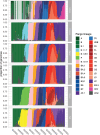SARS-CoV-2 epidemiology, kinetics, and evolution: A narrative review
- PMID: 40197159
- PMCID: PMC11988222
- DOI: 10.1080/21505594.2025.2480633
SARS-CoV-2 epidemiology, kinetics, and evolution: A narrative review
Abstract
Since winter 2019, SARS-CoV-2 has emerged, spread, and evolved all around the globe. We explore 4 y of evolutionary epidemiology of this virus, ranging from the applied public health challenges to the more conceptual evolutionary biology perspectives. Through this review, we first present the spread and lethality of the infections it causes, starting from its emergence in Wuhan (China) from the initial epidemics all around the world, compare the virus to other betacoronaviruses, focus on its airborne transmission, compare containment strategies ("zero-COVID" vs. "herd immunity"), explain its phylogeographical tracking, underline the importance of natural selection on the epidemics, mention its within-host population dynamics. Finally, we discuss how the pandemic has transformed (or should transform) the surveillance and prevention of viral respiratory infections and identify perspectives for the research on epidemiology of COVID-19.
Keywords: COVID-19; modelling; surveillance; variants; virulence; zoonosis.
Conflict of interest statement
No potential conflict of interest was reported by the author(s).
Figures








References
Publication types
MeSH terms
Associated data
- Actions
- Actions
- Actions
- Actions
- Actions
- Actions
LinkOut - more resources
Full Text Sources
Medical
Miscellaneous
